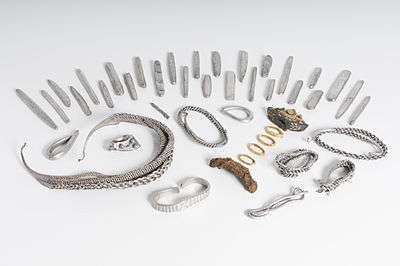Bedale Hoard

The Bedale Hoard is a hoard of forty-eight silver and gold items dating from the late 9th to early 10th century AD and includes necklaces, arm-bands, a sword pommel, hacksilver and ingots. It was discovered on 22 May 2012 in a field near Bedale, North Yorkshire by metal detectorists.[1] Following a successful public funding campaign, the hoard was acquired by the Yorkshire Museum for £50,000.[2]
Contents of the hoard
The hoard contains forty-eight items of silver and gold and was declared as 'treasure' by the Portable Antiquities Scheme.[3] In addition to 29 silver ingots, the hoard contained an iron sword pommel inlaid with foil plaques, four gold hoops or bands from the hilt of the sword, six small gold rivets, four silver collars and neck-rings (one cut into two pieces), one silver arm, one fragment of a 'Permian' ring, and one silver penannular brooch.[3]

Sword fittings
The large, iron sword pommel survived along with the guard, four gold hoops from the hilt and six gold rivets. The pommel is broadly triangular and is inlaid with plaques of gold foil decorated with incised animal interlace with nicked edges in the late Anglo-Saxon Trewhiddle Style, which can be dated to the late 9th century. The form of the pommel is typical of Petersen's late 9th-century type L.[4] Silver is far more usual as a decoration on sword pommels of this date and the extensive use of gold foil on the present find is unique.[3]

Neck-rings
The largest neck collar from the hoard consists of four twisted cables of silver, each a different size, hammer-welded together into flat terminals. The outermost cable consists of six thick, plaited rods and the inner three 'hollow' ropes each consists only of three coiled strands of double-twisted rods. Whilst the individual components of the collar can be paralleled, this 'West Viking' variant is unique.[1][2][3] International trade associated with this hoard is best demonstrated by the 'Permian' style ring fragment,[5] a type imported from Russia during the early part of the Viking period.[6] Two complete six-plait cable neck-rings are also present in the hoard, as is a triple-strand neck-ring cut into half and used as hacksilver.
Ingots
Twenty-nine ingots of silver (with a variety of minor alloys) were found with the hoard, many of which have testing-nicks. Three have crosses incised upon them. They range from 40 to 146 grams (1.4 to 5.1 oz) in weight.[3]
Significance
The hoard represents the scale of international connections in the Early Medieval period, with Russian[6] and Irish[7] influences among the Anglo-Saxon and Anglo-Scandinavian elements. The lack of coinage in this hoard shows the bullion-weight economy in use in the late 9th-century AD.[7] It is earlier than both the Cuerdale Hoard and the Vale of York Hoard.
See also
| Wikimedia Commons has media related to Bedale Hoard. |
- List of hoards in Great Britain
- Anglo-Saxon art
- Kingdom of Northumbria
- Vale of York Hoard
- Cuerdale Hoard
References
- 1 2 "'Viking Hoard revealed in all its beauty'". Northern Echo. 12 December 2014. Retrieved 15 December 2014.
- 1 2 "Bedale Hoard back on display at Yorkshire Museum". Northern Echo. 12 December 2014. Retrieved 15 December 2014.
- 1 2 3 4 5 Barry Ager (26 September 2012). "Hoard, Unique ID: YORYM-CEE620". Portable Antiquities Scheme. Retrieved 15 December 2014.
- ↑ Petersen, J. 1919. De Norske Vikingesverd. En typologisk-kronologisk studie over vikingetidens vaaben Kristiania. 112–116
- ↑ "Beauty of hoard is revealed as rare Viking treasures displayed". Yorkshire Post. 12 December 2014. Retrieved 15 December 2014.
- 1 2 Graham-Campbell, G. 2011. The Cuerdale Hoard and related Viking-Age silver and gold from Britain and Ireland in the British Museum. London: British Museum. 88–89
- 1 2 Townend, M. 2014. Viking Age Yorkshire. Pickering: Blackthorn Press
Coordinates: 54°17′N 1°35′W / 54.29°N 1.59°W